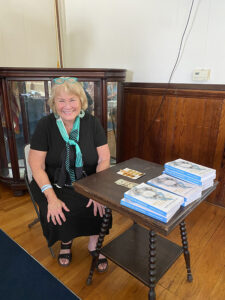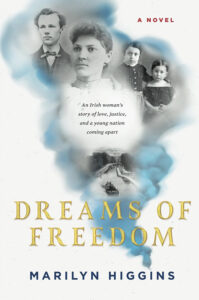‘Dreams of Freedom’
Marilyn Higgins describes her book as ‘a novel with local history, mystery and romance’
By Marilyn L. Pinsky
 When you think of lives well lived, the name Marilyn Higgins rises to the top. Now there is a new chapter in her life.
When you think of lives well lived, the name Marilyn Higgins rises to the top. Now there is a new chapter in her life.
Higgins has written a blockbuster of a book, a love letter to Upstate New York.
Much of it takes place in towns and villages we’ve driven through all our lives but never really knew their histories.
For those who haven’t yet read “Dreams of Freedom,” her debut novel, you’re in for a treat. Or, if you’re like me, who read and loved it when it first came out and picked it up to read again, you’ll enjoy it even more the second time around.
Writing as someone who has known Higgins over the years in her many roles, it was hard when reading the book not to imagine her as her heroine Aileen O’Malley. They are both smart but, first and foremost, kind, caring and very brave people during troubled times in history.
Known nationally for her leadership in the economic development field, Higgins spent much of her 30-year career working to revitalize Upstate New York neighborhoods and communities.
Her first job in the Onondaga County Economic Development Office led her to the Greater Syracuse Chamber of Commerce, followed by becoming the chief economic development officer for National Grid (Niagara Mohawk) and then to Syracuse University where she spent nine years as vice president for community engagement and economic development.
 I asked Higgins what best describes the book to someone who has yet to read it?
I asked Higgins what best describes the book to someone who has yet to read it?
“A novel with local history, mystery and romance. When working with NiMo, I traveled to the counties I write about and their histories always led back to the Erie Canal. I use real characters, like Frederick Douglass and Elizabeth Cady Stanton and weave in fictional characters,” she said.
“Our amazing Upstate history is so little known. I hear from people who say, ‘I’ve lived in this area all my life and no one has ever written a book about my town.’ That people are truly enjoying the book makes me so happy,” she added.
Are there any real-life experiences or people that influenced her fictional characters or the plot?
“Aileen’s grandmother is a lot like my mother’s mom. They were both Irish Catholic, both always learning and changing and spunky. In many ways their story is the story of America,” she explained. “Seven million immigrants came here via the Erie Canal. They discovered they could create a unique future for themselves.
“As Aileen O’Malley’s father came over and settled, my dad’s family was also Irish immigrants and they settled in Pompey. His ancestors fought in the Civil War. When he was a child, his family worked the Armstrong farm overlooking the Erie Canal. He told me stories of taking ice from the canal, packing it in sawdust and dragging it up the hill to the farm to the ice house. That is when my intrigue with the canal first started.”
“This region created whole religious movements that survive to this day. The Mormons from Palmyra and the Shakers from Watervliet are examples. Immigrants were starting their lives over and opened their minds to new faith beliefs and societies. Utopian communities were created like the Oneida Mansion House,” she added. “There was so much religious fervor people called this the “Burned Over District.
“The Erie Canal also made Upstate New York the Silicon Valley of its day. Synthetic penicillin and electricity were invented here. The Women’s Movement and Abolitionist movements were born here. The Haudenosaunee culture served as the basis for our Constitution! Upstate New York changed the world. I want people to understand and appreciate our extraordinary history. This motivated me to write Dreams of Freedom.”
As this book has taken off and word has gotten around, Higgins has won acclaim from other sectors in addition to literature. This fall she will be the speaker for a tour company bringing 30 people from Minnesota to visit Western New York. The company bought everyone on the tour Dreams of Freedom to read in advance for background on what they’ll be seeing. Higgins will meet them in historic Seneca Falls and bring the stories to life.
She will next be providing local color narrative for International Visitors to the World Canal Conference in Buffalo in September for the 200th anniversary of the Erie Canal. The focus of her canal conference speech will be ‘novel tourism,’ a type of tourism that has been around for a long time.
“Think ‘Anne of Green Gables’ and its connection to Prince Edward Island; the ‘Anne Frank House’ and Amsterdam; and ‘The Sun Also Rises’ and Pamplona, Spain, where the bullfighting takes place,” she said. “Novel tourism is what literature can do for a place and for its economic development. Combining the exploration of literature with exploration of the world is a tremendous opportunity for people who are looking for experiences.”
And a wonderful way to spend a fall day or more, is to follow the book’s journey. As one example of trips that Higgins suggests in the book:
Revisit Aileen’s arrival in Canastota followed by a “freedom” afternoon in stunningly beautiful Madison County.
Make reservations for lunch at Center Street Market (where you can taste the best chicken pot pie ever made), then walk around the corner to the Canastota Canal Town Museum. Trace the route of the abolitionists who were driven out of Utica and ultimately formed the NYS anti-slavery society by driving up the hill to Peterboro and visiting the National Abolition Hall of Fame.
Imagine Frederick Douglass chatting with Gerrit Smith in the land office of the Gerrit Smith Estate. On your way back down the hill enjoy views that reach all the way to Lake Ontario. Make a quick turn to visit Nichol’s Pond and stop at the archeological site of a 15th century Oneida village and grain pits. Top off your freedom themed day with an Abolition Ale at the Erie Canal Brewery.
Happy reading and happy travels “Dreams of Freedom” readers.

